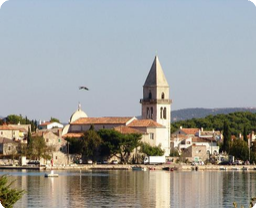

Osor/island of Cres
Osor/island of Cres  What to see in Osor
What to see in Osor
THE TOWN OF OSOR
Old maps have this ancient town marked as Apsoros, Opsara, Apsarus, Absortium, Absyrtim, Absyrtium, Absorum, Opsera, Auserum, Auxerum or Ossero, while in Croatian it is Osor. The meaning of Osor is: rugged, rigid, rough, tough, lofty or put simply an independent, proud town. The name is perfect for a 4,000-year-old town.
Treading on the soil of Osor means treading on a protected archaeological site.
The rural history of the town dates back to the very beginnings of humanity. It is interesting that the clay pot fragments, which combined with stone tools make up the majority of the inventory of the early Neolithic finds in the dwellings in the Vela cave near the top of Mount Osoršćica, have the same characteristics as the so called inpresso-cardum ceramics linked to the Vučedol culture found near Vukovar between the Sava and the Danube rivers. This suggests a connection between the islands and the mainland.
The circular shape of the fortress, which did not change significantly in its long history is still preserved today and dates back to prehistoric times. The Liburnians are credited with building the first dry-wall circular fortress of Osor.
The Cyclopean city walls visible from the south side of the town originate from the time of the Greek colonisation of the Adriatic islands in the fourth century BC. The Romans invaded the island in 167 BC, built defensive towers and built new town gates. The castle and the defence tower with parapets on its roof on the western city gates at the Kavuda channel were demolished in the 19th century.
At the end of the 14th century, the Genoese considerably damaged the town walls. These were repaired after the siege and new walls were built which reduced the town’s size by half. The new walls were rimmed with circular battlements. The town gate was protected by oriels. The elements important for protection did not change significantly in the long history of the fortress town, probably because the sea itself was the real protector of Osor.
To the west of the town walls, generations of inhabitants were laid to rest in the graveyard with diverse burial rites. Some were simply laid in the ground, some were burned and but all disappeared into the depths of the earth. The graves themselves are sources of archaeological material. The 200 amber beads (called electrons) found in one grave confirm that valuable amber was used to purchase freedom of passage through the Osor channel.
This was a passage on the amber route connecting the Baltic parts of northern Europe with the south. This also explains the origin of the names of the Liburnian islands (Cres and Losinj): Elektrides (Electrides)
OSOR MUSIC NIGHTS
The historical area of Osor, in which both ancient and modern theatre performances have taken place since 1586, is a perfect location for a summer music festival that has taken place since 1976 and is called Osor Music Nights. In July and August, the Renaissance Church of the Ascension is the venue for excellent performances by local and international musicians. Besides established works from the European mainstream, one can always hear pieces written by Croatian composers. Osor Music Nights have promoted the works of Boris Papandopulo, Ivan Mato Jarnović, Luka and Antun Sarkočević, Josip Mihovil Stratik, Franjo Krežma and many other artists.
Source: www.jazon.hr
Video
Current news
 Macrocruise charter agency
Additional discount on the boat rental price of betw
Macrocruise charter agency
Additional discount on the boat rental price of betw




























